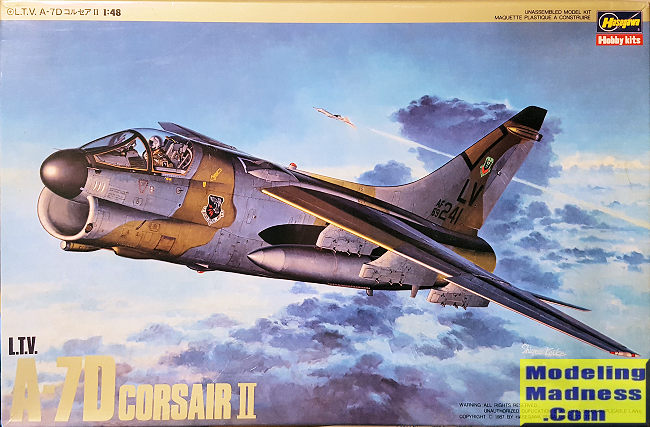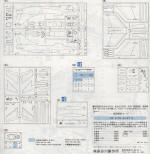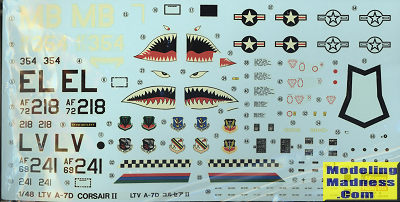
Hasegawa 1/48 A-7D Corsair II
| KIT #: | P13 |
| PRICE: | 2900 yen when new |
| DECALS: | Three options |
| REVIEWER: | Scott Van Aken |
| NOTES: | 1987 release |

| HISTORY |
The United States Army has not been permitted to operate fixed-wing combat aircraft since the establishment of an independent United States Air Force (USAF) in 1947. To meet its need for close air support of its troops in South Vietnam, the Army pressured the Air Force to procure a specialized subsonic close air support fixed-wing aircraft that would suit its needs better than the general-purpose supersonic aircraft that the USAF preferred.
The Vought A-7 seemed to be a relatively quick and inexpensive way to satisfy this need. However, the USAF was initially reluctant to take on yet another Navy-designed aircraft, but Secretary of Defense Robert McNamara was insistent. On 5 November 1965, Secretary of the Air Force Harold Brown and USAF Chief of Staff General John P. McConnell announced that they had decided to order a version of the Corsair II, designated A-7D, for the Tactical Air Command.
The A-7D differed from the Navy's Corsair II in several ways. For one, the USAF insisted on significantly more power for its Corsair II version, and it selected the Allison TF41-A-1 turbofan engine, which was a license-built version of the Rolls-Royce Spey. It offered a thrust of 14,500 lbf (64,000 N), over 2,000 lbf (8,900 N) greater than that of the TF30 that powered the Navy's Corsair IIs. Other changes included a head up display, a new avionics package, and an M61A1 rotary cannon in place of the two single-barreled 20-mm cannon. Also included was a computerized navigation/weapons delivery system with AN/APQ-126 radar.
Two YA-7D prototypes were completed with TF30-P-6 engines, and the first of these flew on 6 April 1968. The first Spey-powered A-7D (67-14854) flew for the first time on 26 September 1968. The seventeenth production aircraft introduced a provision for boom flight refueling in place of the Navy's retractable starboard-side probe/drogue system, with the boom receptacle being on the top of the fuselage behind the cockpit and offset to port.
The USAF operated the A-7 in active duty squadrons until the A-10 came on line and quickly transferred the type to the ANG. The Air Force did not like to admit that it needed USN designed aircraft (F-4 and A-7) to fulfill the majority of its missions during the mid-60s through the 70s, but there it is. During the Vietnam war, the USAF A-7D flew a total of 12,928 combat sorties during the war with only six losses – the lowest of any U.S. fighter in the theater. The aircraft was second only to Boeing B-52 Stratofortress in the amount of ordnance dropped on Hanoi and dropped more bombs per sortie with greater accuracy than any other U.S. attack aircraft.
| THE KIT |
 Hasegawa's
A-7 series was initially released in 1987 and is still what many consider to be
the best A-7 in this scale. While Hobby Boss did a full series of A-7s in this
scale, they apparently based their kit on the Monogram/Aurora kit which has an
intake and canopy that are far too wide, ruining the look of the front of the
aircraft. To my knowledge there is no aftermarket fix for this. Too bad as
apparently it is a good building kit and they do variants that, for some reason,
Hasegawa never bothered doing. This is the D model boxing with the other being
the A-7E.
Hasegawa's
A-7 series was initially released in 1987 and is still what many consider to be
the best A-7 in this scale. While Hobby Boss did a full series of A-7s in this
scale, they apparently based their kit on the Monogram/Aurora kit which has an
intake and canopy that are far too wide, ruining the look of the front of the
aircraft. To my knowledge there is no aftermarket fix for this. Too bad as
apparently it is a good building kit and they do variants that, for some reason,
Hasegawa never bothered doing. This is the D model boxing with the other being
the A-7E.
The kits wings are molded with a number of features. One is that you can
Landing gear
 Instructions
are standard fare for Hasegawa at the time with Gunze paint references. Three
options are provided with three different camouflage schemes. The box art plane
in Euro I is with the 4450th Test Squadron. These planes were used to give F-117
pilots some air time in the early years of the program. Next is an SEA
wraparound scheme on a 74TFS/23 TFW aircraft and finally the original SEA
camouflage one a plane from the 353rd TFS/354th TFW. Decal are probably still
useable after all these years, but the white parts are actually off white and
you'd be wise to get some aftermarket replacements.
Instructions
are standard fare for Hasegawa at the time with Gunze paint references. Three
options are provided with three different camouflage schemes. The box art plane
in Euro I is with the 4450th Test Squadron. These planes were used to give F-117
pilots some air time in the early years of the program. Next is an SEA
wraparound scheme on a 74TFS/23 TFW aircraft and finally the original SEA
camouflage one a plane from the 353rd TFS/354th TFW. Decal are probably still
useable after all these years, but the white parts are actually off white and
you'd be wise to get some aftermarket replacements.
| CONCLUSIONS |
As mentioned, this is still the best in this scale in terms of shape, though it will take some care when building. It is generally still available, though it won't be inexpensive.
| REFERENCES |
https://en.wikipedia.org/wiki/LTV_A-7_Corsair_II#United_States_Air_Force_A-7D
August 2020 Copyright ModelingMadness.com If you would like your product reviewed fairly and
fairly quickly, please
contact
the editor or see other details in the
Note to
Contributors.